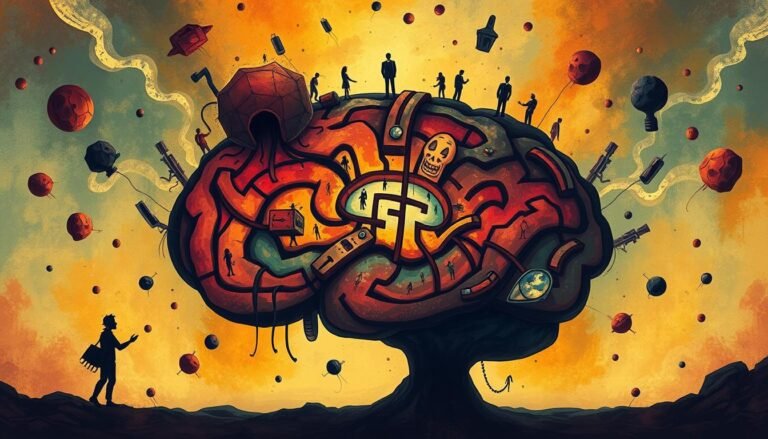Empowering Irish Youth to Prioritize Mental Health and Wellness
Picture a busy school hallway in Dublin. It’s full of lively students excitedly sharing their stories and dreams. Amidst this cheer, Claire, a 16-year-old, finds it tough to handle school and social pressures. Claire’s not alone in her struggle, echoing many teens in Ireland and worldwide. With a record number of young people today—1.8 billion aged 10-24—it’s more important than ever to tackle daily mental health challenges.
In Ireland, a third of the population is under 25. Young people facing unemployment, disabilities, or mental issues find obstacles overwhelming. This is where Enda O’Doherty steps in. His impactful talks and the book “Thriving Mind” share practical tips and encourage mental health importance, wellness, and resilience for teen wellbeing. Everyone, from parents to teachers and the youth themselves, is called to help.
Key Takeaways
- Globally, 1.8 billion youth aged 10-24 make this the largest youth population ever.
- In Ireland, young people aged 10-24 account for 18.3% of a 4.59 million total population.
- Mental health promotion and wellness strategies are crucial for adolescent wellbeing.
- Enda O’Doherty’s “Thriving Mind” offers practical insights into mental health resilience.
- Collective community support is essential in empowering youth to prioritize mental health.
The Current State of Mental Health Among Irish Youth
The mental health situation for young people in Ireland is complex. It involves many challenges and worries. To understand these issues, we look at statistics and common problems teenagers face today.
Statistics on Youth Mental Health
The statistics on mental health are concerning. Ireland is the fourth highest in Europe for suicide among 15-19 year-olds. A study called SEYLE found that 23.7% of Irish teenagers show signs of an anxiety disorder. Also, 14% might have a depression-related disorder.
This data shows the serious need to help these teens. 4% of them have tried to commit suicide. Another 7% thought seriously about suicide. These numbers are worrying and show we must act quickly.
Common Mental Health Challenges
Many Irish teenagers face anxiety and depression. The SEYLE study also found things that can help or hurt teen mental health. This shows we need special ways to help these teens.
The YAM program has been a big help. It lasts four weeks and teaches teens about mental health. It includes acting and workshops. This program has cut down on suicidal thoughts and actions.
Dealing with these challenges means more than just knowing the numbers. We must put real solutions in place. Both national plans and local efforts are needed. It will take a group effort to make a real difference.
The Importance of Mental Health Awareness
Mental health awareness is vital for young people. It helps them build a strong mental well-being base. With focused education and support, we empower youth. We make the world a better place for them.
Why Awareness is Crucial
Being aware is key for a few big reasons. It makes talking about mental health easier and less scary. This way, young people feel okay getting help. Without this, they could face big challenges well into adulthood.
The stress from family changes can make things worse. So, being aware early can really help.
Impact of Awareness on Youth
Knowing about mental health does wonders for the youth. It paves the way for better overall health and happiness. Take, for example, one study in 2010. It found that happiness reduced the chance of future depression. Offering tools and support early tackles mental health issues at their root.
Also, teaching about mental health in schools early can lessen its effects. Research has shown that starting early and providing steady help works. This can cut down how many people face big mental health issues later in life. Real-world studies backup these findings (160:93–9).
National Strategies for Youth Mental Health
As rates of depression, anxiety, and stress rise among youth, Ireland has taken action. The country focuses on improving young people’s mental health. It has introduced strategies to promote and prevent mental health issues.
Overview of the National Youth Strategy 2015-2020
The National Youth Strategy 2015-2020 aims to help young Irish people reach their potential. It covers areas like education, health, and wellbeing. The goal is to create supportive environments and provide access to opportunities, leading to better mental health.
Role of Connecting for Life
Connecting for Life, Ireland’s strategy to reduce suicide, is vital for youth wellbeing. It offers tailored interventions for young people, along with community support and education. These efforts aim to lower self-harm and suicide rates, supporting a safe space for youth.
Sharing the Vision Policy
The Sharing the Vision policy builds on past work to promote mental health at all ages. It focuses on early help, easy-to-reach services, and care that integrates with communities. By tackling mental health’s root social causes and strengthening community bonds, the policy works towards a strong, healthy youth community.
Building Resilience in Young People
Resilience is key to helping young people stay mentally strong and healthy. It’s critical in programs that focus on youth development. This support helps them handle mental health challenges better. Knowing how to be resilient can make a big difference in how well they cope and their mental health.
Defining Resilience
Being resilient means you can bounce back from tough times. It’s about facing problems, overcoming them, and going forward even when it’s hard. Studies by Davydov and Masten show that resilience can lead to better mental health outcomes, especially in tough situations.
Strategies for Building Resilience
There are many ways to help young people become resilient. Things like mindfulness, having supportive friends and family, and joining youth programs are important. Let’s look at some key tips:
- Encouraging strong social connections: Having a network of supportive friends and family is essential for feeling connected and supported.
- Promoting problem-solving skills: Learning to tackle problems step by step helps young people handle tough times better.
- Fostering a positive outlook: Being positive can help young people see challenges as chances to grow instead of impossible hurdles.
Case Studies of Resilience Programs
Many projects worldwide have shown the value of resilience programs. The Asia-Pacific Resilient Children and Communities Project, led by Ungar, improved student mental health and resilience. In Ireland, the Healthy Ireland Strategic Action Plan (2021-2025) aims to boost resilience and mental health among young people with various efforts.
Research in Brazil by Escobar and others has shown the importance of family and school in boosting student resilience, especially in risky situations. These efforts not only tackle current mental health issues but also help young people build long-lasting resilience and mental strength.
The Role of Peer Support Networks
Helping Irish youth focus on their mental health is key. Peer support networks help them do this. These networks let young people connect and support each other. This builds a strong sense of community and positive mental health.
Benefits of Peer Support
Peer support networks have many benefits. They help young people feel they belong and not alone. This is especially important for teens fighting mental health issues. Around 14% of teens have these issues. Peer support can really help ease these troubles.
These networks also help share ways to cope and become stronger. And they can help stop severe mental health problems from happening. They do this by offering easy-to-reach community help when it’s most needed.
Creating Effective Peer Support Networks
Building strong peer support networks needs careful planning. Key steps include:
- Training and Education: Teach peers how to help others with mental health first aid courses.
- Accessibility: Make sure it’s easy for all youth to join, including mobile-friendly options. Mobile interventions can really make a difference.
- Inclusivity: Create a place where every young person feels like they belong. This is crucial to helping the 92% of teens who feel social barriers stop them from seeking help.
- Collaboration with Schools: Work with schools to make peer support available there. Research shows this helps boost support for teens facing suicide risks.
Success Stories from Peer Support Initiatives
Peer support has worked well in many places. A U.S. community outside a big city, for instance, had a peer-support program that helped prevent suicides. This shows how important community aid can be. In Ireland, a “One Stop Shop” for youth health has made teens really happy. The teams there are respectful and supportive. Such stories prove how peer support can make a big difference in mental health care.
Mindfulness Practices for Youth
Mindfulness meditation is a valuable tool for Irish youth to find peace in their minds. It offers multiple advantages, like reducing stress and boosting well-being. This method is gaining popularity, especially in helping young people.
Introduction to Mindfulness
Mindfulness is about staying aware of your thoughts, feelings, and the world around you right now. It teaches us to look at our feelings without being critical. This makes our minds more even. Mindfulness meditation fights stress, anxiety, and blues, crucial for youngsters’ mental health.
Mindfulness Techniques for Teenagers
There are many ways for teens to practice mindfulness each day:
- Breathing Exercises: Focus on your breathing to keep your mind steady.
- Body Scans: Concentrate on different body parts to relax and let go of stress.
- Mindful Walking: Be aware of your surroundings as you walk.
- Mindful Eating: Really notice the taste, feel, and smell of your food.
- Mindful Listening: Fully listen to the sounds around you or to what others are saying.
Evidence of Mindfulness Benefits
A lot of research shows mindfulness is great for young people. It reduces stress a lot, making it easier to handle school and friends. It’s also key in dealing with mental illnesses and avoiding bad habits.
Methods like Mindfulness-Based Cognitive Therapy (MBCT) and Mindfulness-Based Stress Reduction (MBSR) stand out. MBCT stops depression from coming back. And MBSR cuts long stress times, which cause health problems. Mindfulness also boosts relationships, focus, and how young people manage their emotions.
Mindfulness classes, personal coaching, and online guides are all great ways to start. They make mental health better for Irish youth. By using these methods, teens can live in a more mindful and balanced way.
Coping Strategies for Mental Health
Dealing with mental health issues can be hard for teenagers. Using good ways to cope not only helps feel better but also makes them stronger over time. In Ireland, more than 24,500 kids have learned about mental health. They’ve been taught how to handle stress and the importance of having positive ways to cope and being good parents.
There are helpful mental health techniques to manage different stress types:
- Mindfulness and Meditation: These can lower stress and make focusing easier.
- Physical Activities: Doing activities like yoga or playing sports can lift your spirits and reduce anxiety.
- Creative Outlets: Hobbies such as art, writing, or playing music can help manage feelings in a healthy way.
- Peer Support: Having friends and supportive adults can give you advice and support when you need it most.
Starting in 2020, Ireland has worked with groups like Rethink Ireland’s Start-Up Fund to make these tools more available and reliable. Teenagers face a lot of stress from school, trying to fit in, and worrying about money. It’s important that they learn early how to manage stress to avoid more serious problems later.
Youngsters have many things to stress about, from school and starting their careers, to what their friends think and too much screen time. By using coping mechanisms like being mindful, being active, and having friends to lean on, they make their mental health a priority. This helps them deal with stress better.
Almost half the teenagers in Ireland feel a lot of anxiety. The “A Lust For Life Schools Programme” has helped over 85,000 kids learn about mental health in 1,100 schools. This program’s structure has made a big difference in mental health education.
It’s important to tell young people it’s okay to ask for help if they feel down for a long time. There are many useful tools out there, like school counseling or therapy covered by health plans, that can help manage stress. Putting their mental health first can improve their grades and make life more joyful.
The Impact of Stigma on Youth Mental Health
The stigma around mental health greatly affects young people’s efforts to get help. It’s key to understand where this stigma comes from. This helps in making campaigns that actually work to reduce it and create support.
Understanding Stigma
Mental health stigma comes in several types. There’s public stigma, self-stigma, and institutional stigma. Public stigma is when society has a negative view of mental health problems. This can cause people to be treated unfairly or pushed away. Self-stigma is when someone starts to believe and act on these negative views. It can lower their self-esteem and stop them from getting help.
Institutional stigma is about policies and practices in society that don’t help people with mental health conditions. These can make it harder for them to live their lives the way they want.
Strategies for Stigma Reduction
One powerful way to fight stigma is through education. A review of 22 studies including young people between 10 and 19 found that educational programs really make a difference. Eight of these studies showed clear benefits, while 11 had mixed results and three had no effect. But, education is still very important for creating awareness and reducing stigma.
- Implementing mental health education in school curriculums
- Training teachers and staff to recognize and address mental health issues
- Incorporating storytelling from individuals who have overcome mental health challenges
Successful Stigma Reduction Campaigns
Many campaigns have successfully fought mental health stigma among young people. Here are a few examples:
- Mental Health First Aid (MHFA): This program teaches how to offer first support for mental health crises.
- Time to Change (U.K.): A movement that fights prejudice and discrimination through open talks.
- See Change (Ireland): Works towards ending stigma around mental health by involving actions from communities.
These efforts show that reducing mental health stigma has a big impact on society. They encourage more supportive views and make talking about mental health feel normal.
Community Engagement in Promoting Mental Health
It truly takes a village to support mental health and well-being. Local community efforts are key in making mental health resources available to everyone. By coming together, we can ensure that those who need help get the support they require.
Role of Communities in Mental Health
Communities are vital in promoting mental health through support, awareness, and access to services. For example, the Arts Council of New Orleans’ Young Artist Movement (YAM) aids youth. It uses arts education and workforce development to foster their growth.
The Community Center of St. Bernard helps combat food insecurity by offering pantry programs. These efforts support hundreds of families and help reduce mental health challenges.
Community Programs and Initiatives
Local programs highlight the community’s power in mental health. The 504HealthNet’s Healthy Hospitality links hospitality workers to healthcare. This aids both their physical and mental health, showing the importance of community care.
The Cancer Association of Greater New Orleans supports cancer patients. It provides treatment and care, essential for their well-being. Such initiatives are crucial in meeting the specific needs of the community.
There’s also Catholic Charities Archdiocese of New Orleans, offering counseling to those facing mental health issues. These services make a big difference, showing the impact of local support systems.
Empowering Irish Youth to Prioritize Mental Health and Wellness
Empowering Irish youth to put their mental health first is more crucial now than ever. Abuse, neglect, and tough life events up the risk for long-term health problems and mental illness. This makes having strong wellness plans and empowering young people key.
In places like Northern Devon, young people are stepping up to highlight important issues through programs like Kailo. They’re focusing on understanding mental health, finding different job paths, and feeling like they belong. Evidence shows many kids are getting involved, with over 290 taking part.
Recent rises in teenage mental health struggles in the UK show why we need to focus on mental health. Programs should target issues in remote areas, helping all kids get support no matter where they’re from. Big events like the Surgeon General’s meeting and the Rosalynn Carter Symposium stress the need for a care approach that considers past trauma.
Empowerment and wellness strategies are key in our mental health support plans for young people. Using care methods that see and address past trauma can significantly help. Kids, leaders, and health workers working together truly makes a difference in building up a stronger, happier young generation.
Moreover, involving kids in designing health plans helps not only them but also their families and communities. Northern Devon shows how working together can change how we deal with mental health issues. A strong push for mental health awareness promises a future where young people’s well-being and empowerment are fundamental for better societies.
Conclusion
As we close this deep dive into mental health for Irish youth, one thing is clear. Strong community support and committed people are key. Youth Work Ireland shines with over 3000 helpers and 700 staff. They show us how a community can build a safe place for the young.
We’ve talked about many ways to help, from big policies to everyday peer groups. The best results come from mixing different ways to support youth. Even though there are hurdles like tight budgets and not enough proof, these approaches work. They were made to fix a system that didn’t always help young people well. Now, we have systems that find the best way to support those starting to make changes.
Looking ahead, working together and caring for the whole person is important. We can support young people’s mental health by following the UN’s 17 goals. Movements like “Fridays for Future,” started by Greta Thunberg, also help. They show us we can create a better future for our youth. Let’s keep going with our community efforts. Our goal is to give young people the skills and belief they need to succeed.
FAQ
Why is it important to empower Irish youth to prioritize mental health and wellness?
What are the current statistics on youth mental health in Ireland?
What are some common mental health challenges faced by Irish youth?
Why is mental health awareness crucial for youth?
What are the key national strategies for youth mental health in Ireland?
How can resilience be built in young people?
What role do peer support networks play in youth mental health?
How can mindfulness practices benefit youth?
What are effective coping strategies for mental health?
How does stigma impact youth mental health, and what can be done to reduce it?
How can communities engage in promoting mental health among youth?
Source Links
- SDGs & Youth Health – National Youth Council of Ireland
- Empowering Youth in Care on World Semicolon Day: Crafting Stories of Resilience – A Second Chance, Inc.
- Support Services| National FRC Mental Health Promotion Project
- 7.5 Mental health
- Designing and scaling up integrated youth mental health care
- Mental Health Prevention and Promotion—A Narrative Review
- The Importance of Mental Health for Youth in Care – A Second Chance, Inc.
- Fortifying the Foundations: A Comprehensive Approach to Enhancing Mental Health Support in Educational Policies Amidst Crises
- Mental health and psychosocial support | UNHCR
- Training and Events Calendar – Mental Health Technology Transfer Center (MHTTC) Network
- Child and Adolescent Mental Health and Resilience-Focussed Interventions: A Conceptual Analysis to Inform Future Research
- Youth Perspectives on Barriers and Opportunities for the Development of a Peer Support Model to Promote Mental Health and Prevent Suicide
- Frontiers | Community-based programs for youth with mental health conditions: a scoping review and practical implications
- Prevention and early intervention in youth mental health: is it time for a multidisciplinary and trans-diagnostic model for care? – International Journal of Mental Health Systems
- How to look after your mental health using mindfulness
- Niall Breslin
- Mindfulness and Behavior Change
- Home – Children’s Mental Wellbeing
- Mental Health Young Adults – Iris Healing®
- The effectiveness of anti-stigma interventions for reducing mental health stigma in young people: A systematic review and meta-analysis
- Prioritizing Mental health: Breaking the chains of Stigma
- How can we protect, promote, and maintain body image?
- 2023-2026 Community Partners | United Way of Southeast Louisiana
- Engaging The Underserved: Personal Accounts of Communities on Mental Health Needs for Prevention and Early Intervention Strategies
- Key Ingredients for Successful Trauma-Informed Care Implementation
- A community-based approach to identifying and prioritising young people’s mental health needs in their local communities – Research Involvement and Engagement
- Youth Empowerment for Sustainable Development: Exploring Ecosocial Work Discourses








